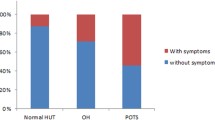Abstract
Orthostatic intolerance is the development of disabling symptoms upon assuming an upright posture that are relieved partially by resuming the supine position. Postural tachycardia syndrome (POTS) is an orthostatic intolerance syndrome characterized by palpitations because of excessive orthostatic sinus tachycardia, lightheadedness, tremor, and near-syncope. Patients usually undergo extensive medical, cardiac, endocrine, neurologic, and psychiatric evaluation, which usually fails to identify a specific abnormality. The authors investigated the autonomic and hemodynamic profile of patients with POTS and the effectiveness of bisoprolol and fludrocortisone. The authors evaluated 11 female patients with POTS before and after medical treatment with a cardioselective bisoprolol β-blocker or fludrocortisone, or both, and 11 age-matched control patients. Variability of heart rate and systolic blood pressure was assessed by fast Fourier transform, and spontaneous baroreceptor gain was assessed by use of the temporal sequences slope and α index. Modelflow was used to quantify hemodynamics. Symptoms in all patients improved greatly after medication. The autonomic and hemodynamic impairment observed in patients with POTS, particularly after orthostatic stress, is treated effectively with bisoprolol or fludrocortisone or both. These results need further confirmation in a controlled double-blind study. Proper medical treatment improves dramatically the clinical and autonomic-hemodynamic disturbances observed in patients with POTS. The data support the hypothesis that POTS is the result of a hyperadrenergic activation or hypovolemia during orthostasis.
Similar content being viewed by others
References
Low PA, Opfer-Gehrking TL, Textor SC, et al. Postural tachycardia syndrome (POTS).Neurology 1995;45(suppl 5):S19-S25.
Narkiewicz K, Someres V. Chronic orthostatic intolerance. Part of a spectrum of dysfunction in orthostatic cardiovascular homeostasis?Circulation 1998;98:2105–2107.
Sandroni P, Opfer-Gehrking TL, Benarroch EE, et al. Certain cardiovascular indices predict syncope in the postural tachycardia syndrome.Clin Auton Res 1996;6:225–231.
Low PA, Opfer-Gehrking TL, Textor SC, et al. Comparison of the postural tachycardia syndrome (POTS) with orthostatic hypotension due to autonomic failure.J Autonom Nerv Sys 1994; 50:181–188.
Omboni S, Parati G, Frattola A, et al. Spectral and sequence analysis of finger blood pressure variability, comparison with analysis of intra-arterial recordings.Hypertension 1993; 22:26–33.
Costa O, Lago P, Rocha AP, et al. Heart rate variability in 24-hour Holter recordings: comparative study between short and long tern time and frequency domain analysis.J Electrocardiol 1994; 27:251–254.
Freitas J, Puig J, Teixeira J, et al. Heart rate variability in brain death.Clin Auton Res 1996;6:141–146.
Welch PD. The use of fast Fourier transform for the estimation of power spectra: a method based on time averaging over short, modified periodograms.IEEE Trans Audio Electroacoust 1967; 15:70–74.
Pagani M, Lombardi F, Guzzeti S, et al. Power spectral analysis of heart rate and arterial pressure variabilities as a marker of sympatho-vagal interaction in man and conscious dogs.Circulation Res 1986;59:178–193.
Eckber DL. Sympathovagal balance: a critical appraisal.Circulation 1997;96(9):3224–3232.
Steptoe A, Vogele C. Cardiac baroreflex function during postural change assessed using non-invasive spontaneous sequence analysis in young man.Cardiovasc Res 1990;24:627–632.
Cerruti C, Barres C, Paultre C. Baroreflex modulation of blood pressure and heart rate variabilities in rats: assessment by spectral analysis.Am J Physiol 1994;226:H1811-H1818.
Watkins LL, Grossman P, Sherwood A. Noninvasive assessment of baroreceptor control in borderline hypertension comparison with the phenylephrine method.Hypertension 1996;28:238–243.
Wesseling KH, Jansen JRC, Settels JJ, et al. Computation of aortic flow from pressure in humans using a nonlinear, three-element model.J Appl Physiol 1993;74(5):2566–2573.
Burkhoff D, Alexander J, Schipke J. Assessment of windkessel as a model of aortic input impedance.Am J Physiol 1988; 255:H742-H753.
Parati G, Casadei R, Groppeli A, et al. Comparasion of finger and intra-arterial blood pressure monitoring at rest and during laboratory testing.Hypertension 1989;13:647–655.
Jellema WT, Imholz BPM, Oosting H, et al. Estimation of beat-tobeat changes in stroke volume from arterial pressure: a comparison of two pressure wave analysis techniques during head-up tilt testing in young, healthy men.Clin Auton Res 1999;9:185–192.
Rosen SG, Cryer PE. Postural tachycardia syndrome. Reversal of sympathetic hyperresponsiveness and clinical improvement during sodium loading.Am J Med 1982;72:847–850.
Hoeldtke RD, Horvath GG, Bryner KD. Treatment of orthostatic tachycardia with erythropoietin.Am J Med 1995;99:525–529.
Low PA. Autonomic Neuropathies.Curr Opin Neurol 1998; 11:531–537.
Fouad FM, Tadena-Theme L, Bravo EL, et al. Idiopathic hypovolemia.Ann Intern Med 1986;104:298–303.
Jacob J, Shannon JR, Black B, et al. Effects of volume loading and pressor agents in idiopathic orthostatic tachycardia.Circulation 1997;96:575–580.
Novak V, Novak P, Opfer-Gehrking TL, et al. Clinical and laboratory indices that enhanced the diagnosis of postural tachycardia syndrome.Mayo Clin Proc 1998;73:1141–1150.
De Lorenzo F, Hargreaves J, Kakkar VV. Possible relationship between chronic fatigue syndrome and postural tachycardia syndrome.Clin Auton Res 1996;6:263–264.
Furlan R, Jacob G, Snell M, et al. Chronic orthostatic intolerance. A disorder with discordant cardiac and vascular sympathetic control.Circulation 1998;98:2154–2159.
Jordan J, Shannon JR, Black BK, et al. Raised cerebrovascular resistance in idiopathic orthostatic intolerance.Hypertension 1998;32:699–704.
Sleight P, La Rovere MT, Mortara A, et al. Physiology and pathophysiology of heart rate and blood pressure variability in humans: is power spectral analysis largely an index of baroreceptor gain?Cli Sci 1995;88:103–109.
Freitas J, Almeida J, Azevedo E, et al. Intolerância ortostatica-revisao e caso clinico.Rev Port Cardiol 1998;17:715–720.
Author information
Authors and Affiliations
Corresponding author
Rights and permissions
About this article
Cite this article
Freitas, J., Santos, R., Azevedo, E. et al. Clinical improvement in patients with orthostatic intolerance after treatment with bisoprolol and fludrocortisone. Clinical Autonomic Research 10, 293–299 (2000). https://doi.org/10.1007/BF02281112
Received:
Accepted:
Issue Date:
DOI: https://doi.org/10.1007/BF02281112




